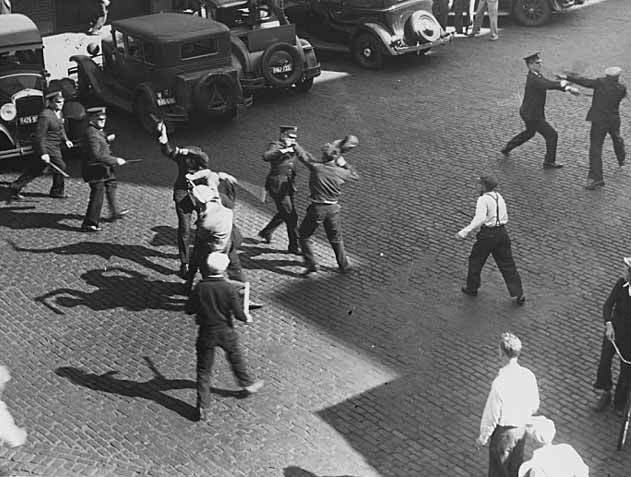

Share
Throughout most of the summer of 1934, the Market District (now known as the Warehouse District) in downtown Minneapolis was full of sensory stimulation: the sound of clubs smashing into heads and bodies along with screams of protest; the sight of blood running in the streets; and the smell of gunpowder.
The 1934 Minneapolis truckers strikes are one of the great watershed moments in the history of the American labor movement. Now a group of labor activists, historians and sympathizers is planning to erect a permanent marker to commemorate the events of that year and to honor those who fell in the struggle for collective bargaining and the right to organize.
“There are virtually no memorials in the Twin Cities related to historical moments in the local labor movement,” said Dave Riehle, who chairs the Remember 1934 Committee. “The ’34 Teamsters strikes were a critical moment in the American labor movement and we believe the time is long overdue for a memorial.”
The Remember 1934 Committee hopes to install the memorial this summer and is soliciting support for the effort.
The 1934 strikes stemmed from the winter of 1933-34 when socialist militants such as the Dunne brothers (Ray, Miles and Grant) and Carl Skoglund effectively shut down delivery of coal during the coldest part of the year. This victory lifted their status as organizers among the area’s truck drivers. By the spring of 1934, anger among the drivers over wages and working conditions had reached such a level that a powerful strike was possible.
The strike began on May 16. It was successful in that it stopped most commercial transportation in the city. Certain farmers were allowed to bring their produce into town, but delivery was directly to grocers rather than to the food wholesale outlets in the market area which the union had shut down.
The union (Local 574; today Teamsters Local 120) was up against the Citizens Alliance, a group of powerful and influential business leaders in Minneapolis vehemently opposed to unions. The Alliance hired goons to augment the police. These people were deputized, provided with clubs made by a local woodworking shop and during the summer physically clashed numerous times with strikers and pickets in the streets of the Market District.
In the latter part of May, a truce was reached and a tentative agreement signed. But by mid-July, the Citizens Alliance and the owners reneged on the agreement and the strike resumed. On what has become known as “Bloody Friday,” unarmed strikers were confronted by police who opened fire with both handguns and shots guns.
When the confrontation ended, 67 strikers were shot and two, Henry Ness and John Belor, died of their wounds. Dr. Hermann McCrimmon, who treated Ness, reported he was shot by a .38 caliber pistol. The bullet entered his lower back and traveled upward, stopping just before exiting his upper chest. That trajectory was possible only if he had been lying face down on the pavement when he was shot, consistent with having crawled under a vehicle for shelter.
By this point, support for the Teamsters had grown, not only among other trade unions but among the public as well. The strikers held strong and remained unified. Victory finally came on Aug. 21.
On that date, federal mediators were notified by the Citizens Alliance of their acceptance of a settlement proposal agreeing to the union’s major demands.
Riehle, a retired locomotive engineer and local labor historian, said the idea for a memorial has been discussed for a couple of decades. Finally, after the observation last year of the 80th anniversary of the strike, a committee was formed with the sole purpose of raising funds, commissioning an artist and making sure the memorial would become reality.
“The plan is to have the memorial completed and erected on or about July 20,” Riehle added.
Keith Christensen, an art professor at St. Cloud State University, is designing a memorial plaque. It will be erected at street level on the building at 701 N. Third St. in Minneapolis. It was in front of this building on Bloody Friday where striker Ness was shot and killed by Minneapolis police.
The plaque will be 30” x 22,” comprised of porcelain enamel in a steel frame and will have text and visuals about the strike and its historical importance.
“Anything which memorializes our fallen brothers and sisters in the struggle for union representation and collective bargaining is a good thing and this memorial is a good thing,” said Paul Slattery, organizer and political director for Teamsters Local 120.
Further information on the project is available by visiting www.gamechange.ampstudio.org.
Persons or groups wishing to make a contribution to the project can send their donation to: Remember 1934, P.O. Box 8115, Lake Street Station, Minneapolis, Minn. 55408.

